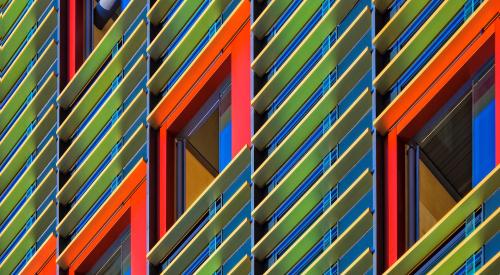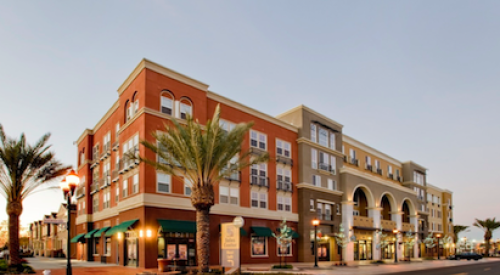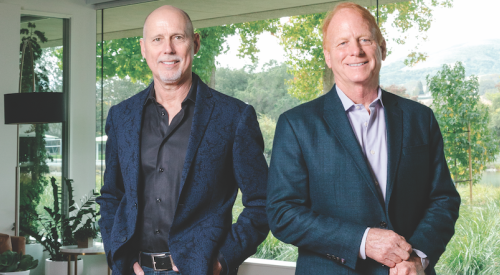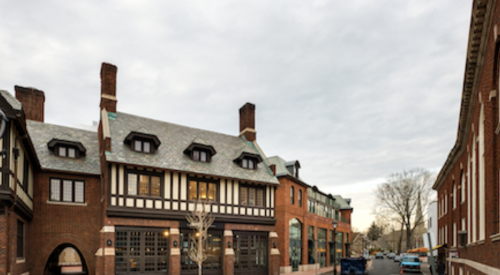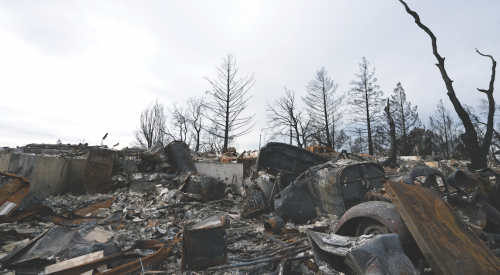The exterior of the East Washington Place Shopping Center in Petaluma, Calif., was designed with a mixture of stucco, stone, brick, glazing, and porcelain tile. The differing materials helped visually define the different stores as though they were separate buildings.
“Fieldstone is a classic look,” says Young Wong, lead architect on the project for MCG Architecture. “It’s durable, not too ‘out there’ in style, and more indicative of the surroundings. Petaluma is out in the country. Stone fits in that area.” Stone comprises about 10 to 15 percent of the exterior surface; it was the largest stone project in Northern California 2013. For the stone veneer, Wong specified the best-known brand of artificial stone.
The 350,000-square-ft mall was striving to be a LEED Silver project. Unbeknownst to the architect, the stone specified, although sold by an American company, is actually manufactured in Mexico. It was arguably within the 500-mile radius required for the locally sourced materials LEED credit — but just barely, and only if measured as the crow flies. In actual transportation distance, it was closer to 600 miles.
The architect was also unaware that a similar product was manufactured just 26 miles way from the project.
When Ed Perez, Northern California area sales manager for Cultured Stone by Boral, heard about the project, he contacted the mayor and city council of Petaluma, and suggested that a locally made product was available, which would provide local jobs instead of sending production work to Mexico.
The city manager contacted the mall owner, Regency Centers. Scott Wilson, vice president of project management received the information.
“We were already through the design process and into construction. I had an interest in looking into Ed’s claim of having a locally sourced product, as well as his claim that the product specified was sourced in Mexico. I saw a benefit to Regency and Boral and everybody to see if it made sense to switch products. It turned out that Cultured Stone by Boral was very competitive from a cost standpoint. Could they provide a product that gives the same or similar look that would be acceptable to City Planning? Yes, it performs comparably. Could they provide the product in the timeline we needed? Yes they could.” The mall’s largest tenant, Target Stores, had a separate architect, but they too came on board with the switch. Target’s design includes a major stone façade.
“Honestly,” says Wong, “we were irritated to have to change stone in the middle of construction.” So Wong decided to conduct an aesthetic test. He took samples of both products, put them side by side, and covered up the labels. Then he assembled representatives from the owner, the general contractor, the masonry subcontractor, the architecture firm, and the city planners. “I said, ‘Which one do you like?’ Everyone, hands down, liked the Boral product immediately. I liked it more. Boral Stone is attractive, it has the wide range of colors we were looking for, it’s cut favorably for the design we had.
The product selected was Aspen Country Ledgestone. “The stone look in the Aspen palette was much truer in the earthtone colors, and the cut was more natural, and that’s what really swung us,” states Wong. “We felt better about using the product that we knew was sourced locally. It was easy to convince owner, the city, and us to the use the stone.
East Washington Place, Petaluma’s largest shopping center, opened for business during the summer of 2013. “Everyone is ecstatic with the way it came out,” says Wong. “My owner is ecstatic, he brags about it every chance he gets. The tenants are happy. This was a win-win for everybody. I will be spec’ing out the Boral product more.”
- East Washington Place Shopping Center, Petaluma, Calif.
- Owner: Regency Centers
- Architect: MCG Architecture, MBH Architects
- General Contractor: MidState Construction and others
- Stone Installers: Diablo Valley Masonry, Randy Haft Masonry

